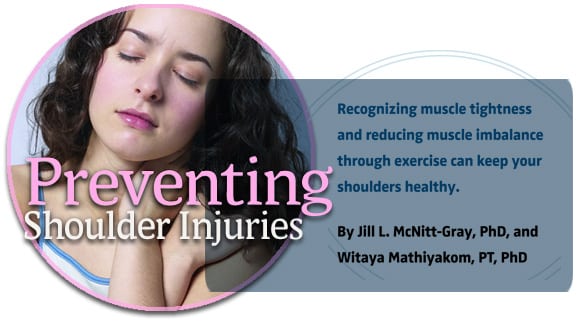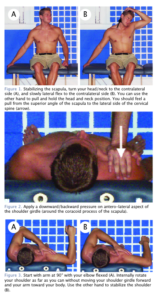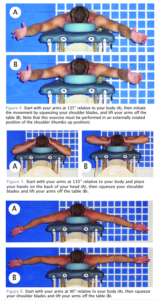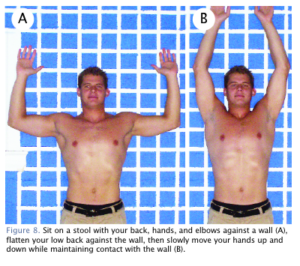
Preventing Shoulder Injuries
Recognizing muscle tightness and reducing muscle imbalance through exercise can keep your shoulders healthy.
Epidemiological studies during the past decade have demonstrated a high incidence of work-related shoulder injuries among dental professionals, most likely due to their sustaining static postures, repeatedly moving within a small range of motion, and completing their work within limited space.1-7 The mechanical load placed on the neck and shoulder during sustained postures often creates an imbalance in muscle length and in the strength of the muscles used to sustain postures and perform repetitive motions.8 These all contribute to postural adaptation.9
Muscle imbalance is the weakness of one muscle/group while its antagonist is strong.10,11 The weaker of the two muscles/groups is usually elongated, while the stronger is shortened.10,11 Shoulder injuries commonly experienced by dental hygienists, such as upper trapezius and levator scapulae myalgia, thoracic outlet syndrome, and supraspinatus tendinitis,2 are often related to muscle imbalance. For example, a prolonged scapular elevation posture that is common among dental hygienists requires the upper trapezius and levator scapulae muscles to contract isometrically. The activation of these two muscles without alternation in muscle length reduces blood circulation, creates microtrauma, and, over time, leads to upper trapezius and levator scapulae muscle pain. Static contraction of the upper trapezius and levator scapule muscles also results in adaptive shortening of these muscles and leads to an elevated scapula. As the scapula becomes elevated, the lower trapezius muscle (the antagonistic muscles of the upper trapezius and levator scapulae) becomes elongated and begins to weaken,3 thereby increasing the susceptibility to future injury.
Another common posture among dental hygienists is the forward or rounded shoulder. When sustaining this posture, the anterior muscles, such as the pectoralis minor and pectoralis major muscles, become shortened, stiff, and tight.3,7,10 Tightness of the pectoralis minor compromises mobility of the brachial plexus, particularly the ulnar nerve, and the axillary artery and vein that run beneath the muscle. The increase in compression associated with tight muscles may lead to thoracic outlet syndrome (a group of distinct disorders that affect the nerves in the brachial plexus and various nerves and blood vessels between the base of the neck and armpit). Tightness of the pectoralis minor also contributes to elongation of the lower and middle trapezius muscles, which can reduce the force generating capabilities of the muscles. Weakness in these two trapezius muscles disrupts the upward rotation of the scapula necessary during arm elevation, thereby contributing to shoulder impingement, supraspinatus tendinitis, and rotator cuff injury.
Dental hygienists maintain the shoulder abduction position more than 50% of the time while working.4 To maintain the position of the humeral head within the glenoid fossa, activation of the deltoid muscle (glenohumeral abductor) must be counterbalanced by adequate activation of the rotator cuff muscles. Imbalance between activation of the deltoid and rotator cuff muscles, particularly subscapularis muscle, often leads to the anterior and/or superior translation of the humeral head relative to the glenoid fossa. Inability to control the humeral head position during arm elevation can lead to impingement syndrome of the shoulder (a common shoulder condition seen in aging adults closely related to shoulder bursitis and rotator cuff tendinitis), bicep tendinitis, and rotator cuff injury.11
DETERMINING YOUR TIGHTNESS
Although the scapular elevators (upper trapezius and levator scapulae) elevate the scapula, they also extend and lateral flex the cervical spine to the ipsilateral side. To test the tightness of the right levator scapulae muscle (Figure 1), stabilize the right scapula by holding onto a chair seat, rotate your head/neck 45° to the left, and lateral flex your head/neck to the left. To test the length of the upper trapezius, follow the same procedure used for the levator scapulae muscle with the exception of head/neck rotation to the contralateral side. The range of levator scapulae and upper trapezius is approximately 35° to 40°.
Tightness of the pectoralis minor tilts the scapula forward. From the sagittal (side) view, notice that the inferior angle of the scapula protrudes backward. If the pectoralis minor is tight in supine, the posterior aspect of the acromion is elevated above the bed by more than 1 inch.
An important function of the posterior rotator cuff muscles is to position the humeral head within the glenoid fossa during arm elevation. Prolonged contraction of these muscles during dental hygiene work alters the length and strength of the rotator cuff muscles. Tightness of these muscles will limit shoulder internal rotation. In general, normal range of shoulder internal rotation is less than 70°.
STRENGTHENING EXERCISES
These exercises can be performed on any flat firm table or bed. Make sure the table is stable and wide enough to support the whole body.
1. Lengthening exercise of the levator scapulae and upper trapezius muscles. To stretch these two muscles, follow the same procedures used to test their length (Figure 1). At the end range, use the other hand to pull and hold the stretch position for at least 30 seconds, then slowly return to the neutral starting position. During the stretch, you should feel a firm but tolerable pull in the area being stretched. Repeat the stretch three to five times.
3. Lengthening exercise of the shoulder external rotator muscles. Start with your arm at 90° with your elbow flexed, internally rotate your shoulder as far as you can without moving your shoulder blade, using the other arm to stabilize the shoulder (Figure 3). Hold the stretch position for at least 30 seconds and repeat the stretch three to five times.2. Lengthening exercise of the pectoralis minor muscle. To stretch this muscle, you need another person to help. Lie down on your back with both knees bent and feet flat. Have the assistant place his/her hand over the coracoid process, which is about 2/3 away from the midline of the body and 1 inch below the clavicle. The assistant should press the coracoid process back and down firmly and hold for 60 seconds (Figure 2). Repeat the stretch three to five times.
4. Strengthening exercise of the lower trapezius muscle. This exercise can be used to gain muscle force, generating balance between the lower trapezius, upper trapezius, and the pectoralis minor. Lie prone on your stomach with your arms at 135° relative to your body with elbows extended and your thumbs pointing upward. This position places your scapula in an upwardly rotated and abducted position. Squeeze the shoulder blades together then lift the arms off the table (Figure 4). Hold the scapular and arm positions for 6 seconds, then slowly return to the starting position. Repeat eight to 10 times for two to three sets as long as you can maintain the form during the exercise. If the inferior angles of the scapula rotate backward toward the midline of the body, use the rhomboid muscles to do the work. You may need to do the exercise with the flexed elbows position (Figure 5). Make sure you are not over-using the upper trapezius during this exercise. The upper trapezius and pectoralis minor should also be stretched before beginning this exercise.
5. Strengthening exercise of the middle trapezius muscle. In people with rounded shoulders, the middle trapezius muscle commonly becomes long and weak. This exercise helps strengthen the middle trapezius. Lie prone on your stomach with your arms at 90°, elbows extended, and thumbs up. Squeeze the shoulder blades together then lifting the arms off the table (Figure 6). At end range, hold your scapular and arm positions for 6 seconds. Repeat eight to 10 times for two to three sets as long as you can maintain the form during the exercise. Again, make sure you’re not over-using the rhomboid muscles. If you cannot perform this exercise correctly, use the flexed elbow position.
6. Strengthening exercise of the shoulder internal rotator. This exercise is done in prone position with your arm at 90° and elbow flexed. You will internally rotate your shoulder by bringing your hand backward and toward the ceiling without moving your elbow and scapula. At the end range, hold for 6 seconds (Figure 7). You can repeat the exercise eight to 10 times, for two to three sets as long as you can maintain the proper form.
7. Wall-sitting postural exercise. Sit on a stool with your back, hands, and elbows against a wall but do not lean onto the wall. Flatten your low back against the wall by pulling your stomach in and up. Then slowly move your hand up and down while maintaining the contact with the wall (Figure 8).
Dental hygienists have many options to protect their musculoskeletal health—from wearing loupes to using ergonomic chairs. Incorporating a routine of strengthening exercises into the injury prevention arsenal is another important facet of maintaining health.
REFERENCES
- Akesson I, Hansson GA, Balogh I, Moritz U, Skerfving S. Quantifying work load in neck, shoulders and wrists in female dentists. Int Arch Occup Environ Health. 1997;69:461-474.
- Akesson I, Johnsson B, Rylander L, Moritz U, Skerfving S. Musculoskeletal disorders among female dental personnel—clinical examination and a 5-year follow-up study of symptoms. Int Arch Occup Environ Health. 1999;72:395-403.
- Jacobsen N, Hensten-Pettersen A. Occupational health problems among dental hygienists. Community Dent Oral Epidemiol. 1995;23:177-181.
- Marklin RW, Cherney K. Working postures of dentists and dental hygienists. J Calif Dent Assoc. 2005;33:133-136.
- Oberg T. Ergonomic evaluation and construction of a reference workplace in dental hygiene: a case study. J Dent Hyg. 1993;67:262-267.
- Osborn JB, Newell KJ, Rudney JD, Stoltenberg JL. Musculoskeletal pain among Minnesota dental hygienists. J Dent Hyg. 1990;64:132-138.
- Yee T, Crawford L, Harber P. Work environment of dental hygienists. J Occup Environ Med. 2005;47:633-639.
- Johnson EG, Godges JJ, Lohman EB, Stephens JA, Zimmerman GJ, Anderson SP. Disability self-assessment and upper quarter muscle balance between female dental hygienists and non-dental hygienists. J Dent Hyg. 2003;77:217-223.
- Barry RM, Woodall WR, Mahan JM. Postural changes in dental hygienists. Four-year longitudinal study. J Dent Hyg. 1992;66:147-150.
- Kendall FP, McCreary EK, Provance PG, Rodgers MM, Romani WA. Muscles Testing and Function with Posture and Pain. 5th ed. Baltimore, Md: Lippincott Williams & Wilkins; 2005.
- Sahrmann SA. Diagnosis and Treatment of Movement Impairment Syndromes. St Louis: Mosby; 2002.
From Dimensions of Dental Hygiene. January 2007;5(1): 16-18.



